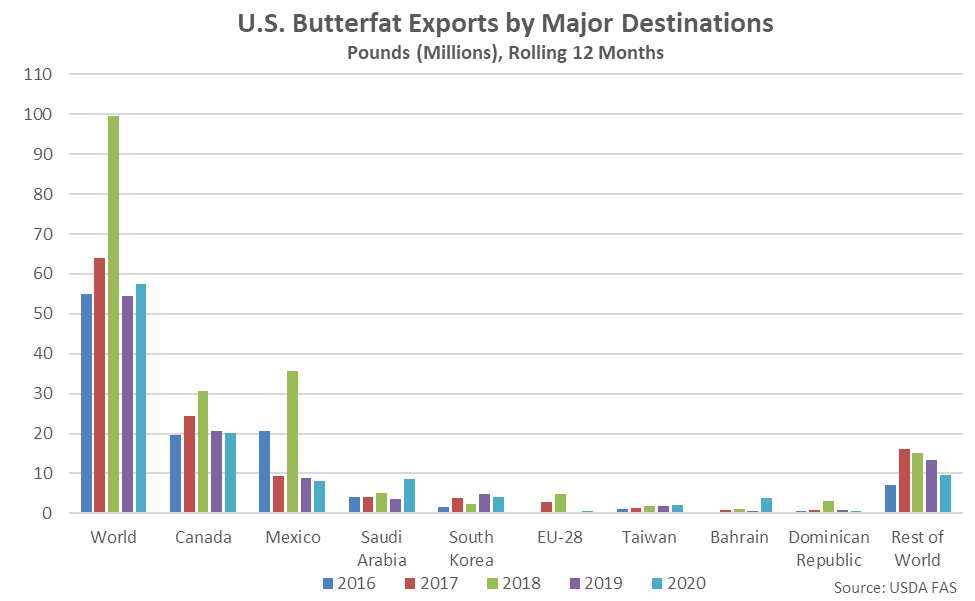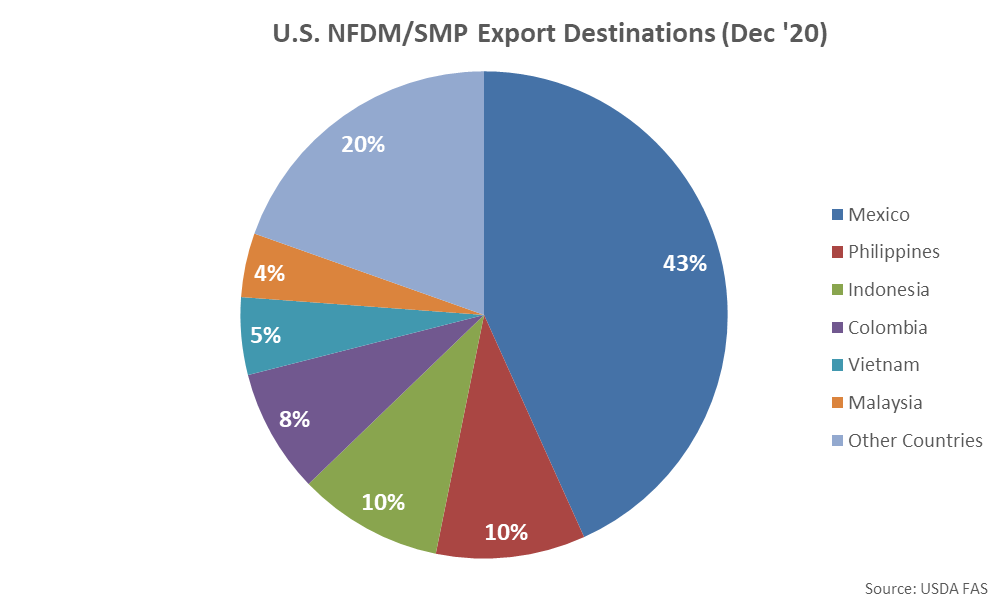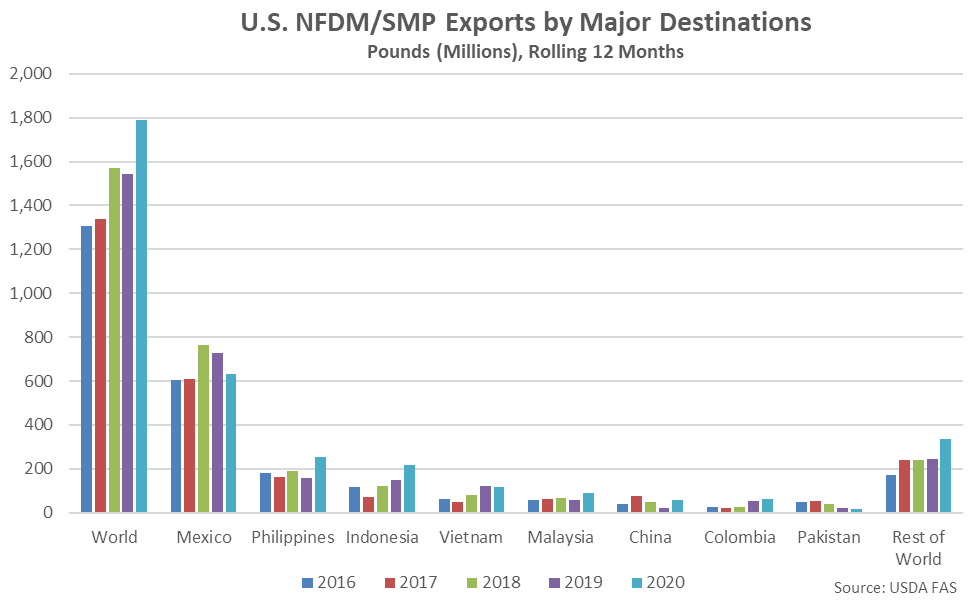U.S. Dairy Exports Update – Feb ’21
Executive Summary
U.S. dairy export figures provided by the USDA were recently updated with values spanning through Dec ’20. Highlights from the updated report include:
- U.S. butterfat export volumes rebounded to a two year high level throughout Dec ’20, finishing 115.2% higher on a YOY basis. Net butter trade remained at a negative level for the 32nd consecutive month, however.
- U.S. cheese export volumes declined 1.0% on a YOY basis throughout Dec ’20, remaining at a five year low seasonal level for the third consecutive month. U.S. dry whey export volumes increased 36.6% on a YOY basis throughout Dec ’20, however, reaching a three year high seasonal level, while whey protein concentrate export volumes increased 28.1% YOY throughout the month, also reaching a three year high seasonal level.
- U.S. nonfat dry milk/skim milk powder export volumes declined 14.7% on a YOY basis throughout Dec ’20, finishing lower for the third time in the past four months.
Additional Report Details
Butter – Exports Rebound to a Two Year High Level However Net Trade Remains Negative
According to the USDA, Dec ’20 U.S. export volumes of butterfat rebounded to a two year high level, finishing 115.2% higher on a YOY basis. The YOY increase in butterfat export volumes was the fifth experienced throughout the past seven months. Butterfat import volumes continued to exceed export volumes for the 32nd consecutive month, however, throughout Dec ’20.
’19-’20 annual butterfat export volumes declined 24.1% on a YOY basis, reaching a four year low level. ’20-’21 YTD butterfat export volumes have rebounded by 41.6% on a YOY basis throughout the first quarter of the production season, however.

Canada was the top destination for U.S. butterfat export volumes throughout Dec ’20, accounting for over a quarter of the total export volumes. Canada, Mexico, Bahrain and Saudi Arabia combined to account for over 85% of all butterfat export volumes throughout the month.

Butterfat export volumes destined to Bahrain increased most significantly on a YOY basis throughout the month, followed by shipments destined to Saudi Arabia and Canada, while butterfat export volumes destined to Israel finished most significantly lower.

Canada and Mexico have historically been the largest importers of U.S. butterfat, accounting for nearly 60% of the total U.S. export volumes experienced throughout the past five years. U.S. butterfat export volumes destined to Canada and Mexico have declined by 2.0% and 8.7%, respectively, on a YOY basis throughout the past 12 months, compared to a 16.9% YOY increase in U.S. butterfat export volumes destined to all other countries.

Cheese – Export Volumes Remain at a Five Year Low Seasonal Level, Finish Down 1.0% YOY
U.S. cheese export volumes declined 1.0% on a YOY basis throughout Dec ’20, remaining at a five year low seasonal level for the third consecutive month. The YOY decline in cheese export volumes was the third experienced in a row but the smallest experienced throughout the three month period on a percentage basis. Cheddar cheese export volumes declined 10.3% on a YOY basis throughout the month, more than offsetting a 0.4% YOY increase in other-than-cheddar cheese export volumes.
’19-’20 annual cheese export volumes increased 2.4% on a YOY basis, reaching a six year high level. ’20-’21 YTD cheese export volumes have declined by 10.2% on a YOY basis throughout the first quarter of the production season, however, and are on pace to reach a five year low level.

Mexico, South Korea and Japan were the top destinations for U.S. cheese export volumes throughout Dec ’20, combining to account for over half of the total export volumes.

YOY declines in cheese export volumes were led by product destined to Mexico, while cheese export volumes destined to Japan finished most significantly higher. A 20.1% YOY decline in cheese exports destined to Mexico more than offset a 9.5% YOY increase in volumes destined to other countries throughout the month.

Mexico and South Korea have historically been the largest importers of U.S. cheese, accounting for nearly 45% of total U.S. cheese export volumes throughout the past five years. Combined U.S. cheese export volumes destined to Mexico and South Korea have increased 4.1% on a YOY basis throughout the past 12 months.

Whey – Dry Whey and Whey Protein Concentrate Exports Each Reach Three Year High Seasonal Levels
U.S. dry whey export volumes increased on a YOY basis for the 11th consecutive month during Dec ’20, finishing up 36.6% and reaching a three year high seasonal level. Dry whey export volumes had finished lower on a YOY basis over 17 consecutive months prior to the 11 most recently experienced YOY increases.
’19-’20 annual dry whey export volumes rebounded 15.6% on a YOY basis from the 15 year low level experienced throughout the previous production season. ’20-’21 YTD dry whey export volumes have increased by an additional 66.6% on a YOY basis throughout the first quarter of the production season and are on pace to reach a three year high level.

U.S. whey protein concentrate (WPC) export volumes increased 28.1% on a YOY basis during Dec ’20, also reaching a three year high seasonal level. The YOY increase in WPC export volumes was the sixth experienced in a row. ’19-’20 annual WPC export volumes increased 18.4% on a YOY basis while ’20-’21 YTD export volumes have increased an additional 19.0% YOY throughout the first quarter of the production season.

China was the top destination for U.S. whey export volumes throughout Dec ’20, accounting for nearly half of the total export volumes. China and Mexico combined to account for over half of the total Dec ’20 U.S. dry whey export volumes.

YOY increases in whey export volumes continue to be led by product destined to China, while volumes destined to Mexico finished most significantly lower on a YOY basis throughout the month.

China has historically been the largest importer of U.S. whey products, accounting for over a third of the total U.S. whey export volumes throughout the past five years. U.S. whey export volumes destined to China have increased 114.7% YOY throughout the past 12 months, more than offsetting a 3.0% YOY decline in whey export volumes destined to all other countries over the same period. Chinese whey demand has rebounded of late from reduced levels stemming from weaker feed demand due to African swine fever.

NFDM/SMP – Export Volumes Decline YOY for the Third Time in Four Months, Finish Down 14.7%
Dec ’20 U.S. export volumes of nonfat dry milk (NFDM) and skim milk powder (SMP) declined 14.7% on a YOY basis, finishing lower for the third time in the past four months. NFDM/SMP export volumes had finished higher on a YOY basis over 11 of 12 months through Aug ’20, prior to declining over three of the most recent four months of data. Despite declining on a YOY basis, Dec ’20 NFDM/SMP export volumes remained at the third highest seasonal level on record.
’19-’20 annual NFDM/SMP export volumes increased 25.4% on a YOY basis, reaching a record high level. ’20-’21 YTD NFDM/SMP export volumes have declined by 4.5% on a YOY basis throughout the first quarter of the production season, however.

Mexico was the top destination for U.S. NFDM/SMP export volumes throughout Dec ’20, accounting for two fifths of the total export volumes. Mexico and the Philippines combined to account for over half of the total Dec ’20 U.S. NFDM/SMP export volumes.

YOY declines in NFDM/SMP export volumes were led by product destined to Vietnam, followed by volumes destined to Columbia and Chile, while export volumes destined to Malaysia and Mexico finished most significantly higher on a YOY basis throughout the month.

Mexico has historically been the largest importer of U.S. NFDM/SMP, accounting for nearly 45% of all U.S. NFDM/SMP export volumes throughout the past five years. U.S. NFDM/SMP export volumes destined to Mexico have declined 13.0% on a YOY basis throughout the past 12 months while volumes destined to all other countries have increased 41.1% YOY over the same period.

Export Volumes Normalized to Production
U.S. butterfat and dry whey export volumes as a percentage of production finished above previous year figures during Dec ’20 while NFDM/SMP export volumes as a percentage of production finished lower. Cheese export volumes as a percentage of production finished flat on a YOY basis throughout the month.

Overall, U.S. dairy export volumes were estimated to be equivalent to approximately 14.9% of total U.S. milk-solids production during Dec ’20 while dairy import volumes were estimated to be equivalent to approximately 3.5% of total U.S. milk-solids production. Dec ’20 net dairy trade was estimated to decline 1.8% on a YOY basis, finishing lower for the second consecutive month. Net dairy trade had increased on a YOY basis over 12 consecutive months prior to the two most recently experienced declines.

U.S. dairy exports as a percentage of milk-solids production is estimated to have declined on a YOY basis for the second consecutive month during Dec ’20, finishing down 1.9%. ’19-’20 annual exports as a percentage of milk-solids production finished 11.8% above previous year levels but remained below the ’17-’18 record high figures. ’20-’21 YTD exports as a percentage of milk-solids production remain up an additional 2.2% on a YOY basis throughout the first quarter of the production season.

Dec ’20 U.S. dairy imports as a percentage of milk-solids production declined 2.0% on a YOY basis, finishing lower for the tenth consecutive month. ’19-’20 annual imports as a percentage of milk-solids production finished 4.5% below previous year levels while ’20-’21 YTD imports as a percentage of milk-solids production have declined by an additional 1.9% on a YOY basis throughout the first quarter of the production season.

Net trade of U.S. NFDM/SMP continued to outpace that of butter, cheese and dry whey as import volumes remain minimal. Net dry whey trade volumes exceeded net cheese trade volumes for the fifth consecutive month throughout Dec ’20 while the U.S. finished as a net importer of butter for the 32nd consecutive month.
